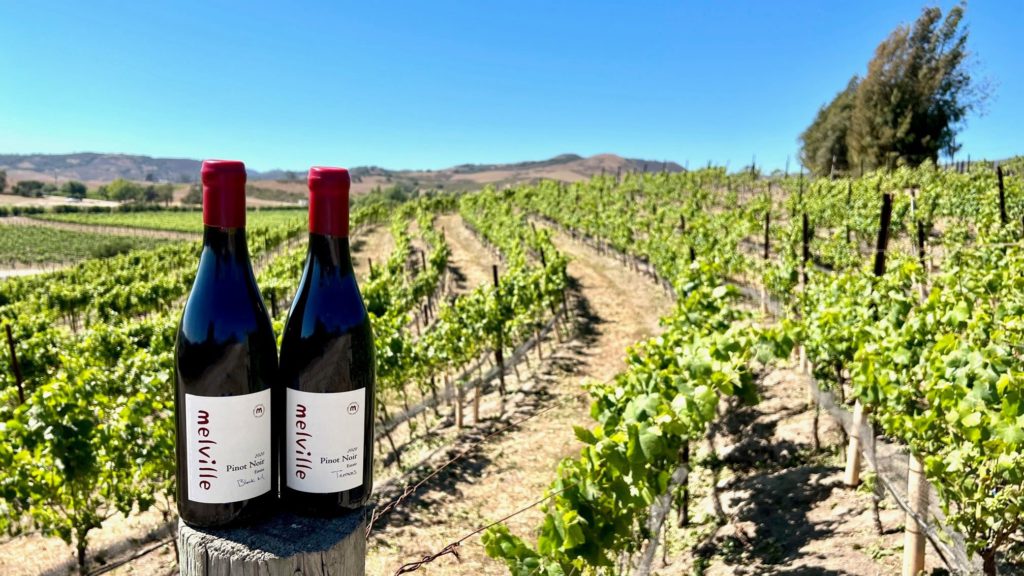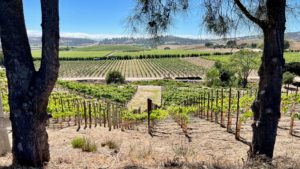A Westside Story

Tale of two wines….
To the west of our winery, out yonder and over a hill, lies one of our most beautiful and varied vineyard locations, our Westside Vineyard. This area was the first site planted by Brent Melville back in 1997 and is the home of a number of different blocks of pinot noir, syrah and chardonnay. Join us as we take a little hiking journey around two of our pinot noir sections, Block M and Terraces, and tell a westside story of these two fascinating locations and the compelling wines they produce…

Block M – high on a hilltop, elevated extremes
You might feel a little huff-and-puff as you head up the farm road to the top of the hill (unless you’re Chad’s son Caden on an ATV), as the incline is fairly steep. At the top, Block M makes up the highest elevation of vines planted on our entire estate. We’ve got our hats, sunglasses and good shoes on…luckily it’s a hill, not a mountain, so it’s a quick, yet steep, jaunt up.
When we arrive at the top (only a tad out-of-breath) the first thing we notice is the wind. We were told it gets windy here…but WOW, we might as well be on a mountain! Due to the proximity to the Pacific Ocean and the “wind-tunnel” like valley to the west, these cold winds start to pick up in the early afternoon (year-round) and can be gusty and brutal. It’s mid-July, the ocean temp is 57 degrees and the summer wind feels cold (imagine the chill in winter.) While the rest of the country endures a blazing heat-wave, the Sta. Rita Hills’ micro-climate stays cool…a welcome respite and unique characteristic of this magical winegrowing region. Fortunately (for the vines), there is a “wind break” row of evergreen Casuarina trees at the edge of the hill, but if you’re out here after 1pm…hold onto your hat, your sunglasses and your small children (just kidding with that one). You get it…it’s WINDY! 
Thank goodness it’s also sunny. Although this area is often blanketed by the morning coastal fog…this hilltop opens up and is followed by direct (albeit cold) sunshine. These vines are planted north to south, so being elevated on a mesa, the fruit is evenly exposed to sun all day. No wonder it’s often one of our first blocks to ripen and come in at harvest.
Walking among the rows (watching our step) we stop to take note of the soil, and dig our hands right in. Feel it, smell it, let it crumble through our fingers. What do we have here? A compact, botella clay. It’s sticky, feels like clay…but smells fresh, clean and alive, oceanic and salty. Underneath the topsoil is an 18 inch hardpan…yep, this soil must be quite hard in order for this hill to even exist. Otherwise, it would have eroded long ago and we’d be standing in the flat-lands like the valley below.
These vines appear young…they are 25-years old, but don’t look more than 8. Why’s that? Stress. The hard soil not only keeps the hill in tact, but makes it difficult for the roots to penetrate and grow. Combined with the wind, the cold, the sun…this area is stressed, this area is extreme. For winegrowing, however, this is a good thing, if…
 …we farm the right way. For all of our blocks, our efforts are to nurture the vines and provide balance to the specific challenges they face (sun, wind, compact soil, etc.)…and when we do, Block M delivers. Block M is tough…like a marathon runner, a mountaineer, hanging in there day-after-day, battling the elements, yet being nurtured by our crew. So what’s the result?
…we farm the right way. For all of our blocks, our efforts are to nurture the vines and provide balance to the specific challenges they face (sun, wind, compact soil, etc.)…and when we do, Block M delivers. Block M is tough…like a marathon runner, a mountaineer, hanging in there day-after-day, battling the elements, yet being nurtured by our crew. So what’s the result?
Block Magic…the vines produce small berries and clusters, leading to a rich and full-bodied wine with a lush, tender texture, and concentrated, high-toned fruit components. Think black cherry, fig and plum sauce, followed by cassis, black currant and muddled blackberry. Soft, round tannins…leave you craving more. The clay soil, the hilltop exposures, and the magic of the Sta. Rita Hills terroir are expressed beautifully in this vibrant wine. We can’t wait to sip some back at the winery after exploring this incredible place, but first let’s check in on another location…
Terraces – responds to the elements with intense fruit
 From atop the mesa of Block M, we head west towards the trees and find a little section between them to peek out. We feast our eyes upon beautiful terraced vines, cascading down the hill we just hiked up. What a sight to behold…such stunning panoramic views sweeping across the valley.
From atop the mesa of Block M, we head west towards the trees and find a little section between them to peek out. We feast our eyes upon beautiful terraced vines, cascading down the hill we just hiked up. What a sight to behold…such stunning panoramic views sweeping across the valley.
Aptly named “Terraces,” this 4.9 acre terraced block sits upon a steep slope, and wraps around Block M in a “peninsula” shape, with each individual row receiving a direct hit from the cold Pacific Ocean wind (no wind break here, kids). Gazing out, we notice the many hawks circling and gliding above, soaring in the wind. We see (and feel) the wind blowing and rumbling through the vines, with very little pause between gusts. Stay strong, little friends!
 These terraced rows face varying directions – north, northwest, and due west – receiving several different sun exposures, with each row at it’s own elevation. To boot, the facets of a terraced block lead to a limited water holding capacity. It must be a challenge for our vineyard crew to manage all the different variables. (Don’t fret – they got this!)
These terraced rows face varying directions – north, northwest, and due west – receiving several different sun exposures, with each row at it’s own elevation. To boot, the facets of a terraced block lead to a limited water holding capacity. It must be a challenge for our vineyard crew to manage all the different variables. (Don’t fret – they got this!)
We scoop up some soil and notice the differences in smell and texture, compared to Block M. This terraced soil is made of a clay-rich loam with calcareous shale. It looks different too, chunkier with some white. Why do we talk about soil? Well, aside from soil needing to be healthy for any plant to thrive, wine (and especially pinot noir) reflects the characteristics of the soil in which it grows. Why does Block M taste different than Terraces? or Sandy’s? (grown in sandy soil over on the eastside). One component is the soil. Think about that next time you’ve got a glass of pinot in hand…

Standing atop this beautiful hillside, we truly absorb first-hand the exposure and intensity of the terraces. We feel exposed ourselves being out here, and it’s only been about an hour! It’s quite impressive to see and feel what these terraced vines endure. These challenges, Chad tell us, lead to a naturally “devigorized” environment. How does Terraces respond? By producing intense fruit. Grippy tannins, defined acidity… mouthwatering flavors of plum compote, clove and herbal tea.
On that note, we’re starting to feel thirsty so it’s time to conclude our tour and story of Block M and Terraces. It’s been a lovely and educational experience, and some of us feel like running back up to Block M to spin with our arms out (a-la Julie Andrews in the Sound of Music)…‘the hills are alive’…because they are, alive, we feel it. The one thing we ALL can agree on, however, is that we’re ready to get into our warm, wind-free car, head back to the winery and drink some of this bad-ass pinot…
THE END
Looking for an even happier ending? Here you go…we are in the midst of organizing a new seasonal, immersive tour experience where you can venture out in the vineyards with a guide, to see, feel and taste the magic yourself! Stay tuned…



